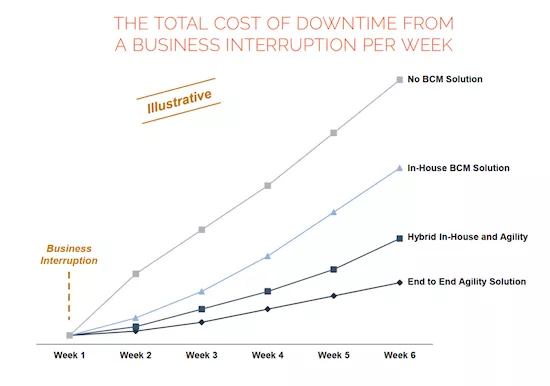8 Most Common Obstacles to Business Continuity Programs

A business continuity plan is vital to help safeguard your business and minimize disruptions. However, setting up a business continuity program isn’t always that easy. It comes with its own challenges and obstacles. Overcoming these business obstacles can be tough, but it is possible with the right support.
With education and the recent experience of a disruption being the most effective triggers for businesses to adopt a BCP*, the challenges are plentiful.
We gathered some of the most common obstacles to business continuity programs, along with the ways to overcome them.
1. Lack of Resources
When you’re running a business, you aim to make money.
Diverting resources to business continuity programs may slow down the growth of your business. What’s more, there is no apparent benefit from a business continuity program when everything is going well. You’ll only truly reap the benefits in case of business interruption.
Trying to run a robust business continuity program can be a challenge when you’re not given the budget, manpower, or resources to do things properly. One of the best ways to ensure that you are getting everything you need is to make a clear budget of the exact costs of the program. Then estimate the costs to the business if something went wrong without the plan in place.
There should be a significant difference between the two. You can show senior management that business continuity is an investment. If all else fails, show them exactly how much your competitors are spending on disaster recovery; this should appeal to their competitive nature if nothing else.
2. Lack of Executive Support
Even with a clear cost-benefit analysis, you may still be lacking enthusiastic support from the top.
There is a lot of risk-taking in business, and you may find that management is more inclined to take the risk that nothing major will go wrong, rather than spend money to prepare for business disruption. Changing that mindset and getting management’s buy-in can be a real challenge.
One way that may you be able to overcome this issue is to provide them with some real-world case studies that show the dangers to businesses just like yours. You can then explain how your business continuity program can keep your business running even through the very worst scenarios.
You should also show them how your program will benefit the business before, during, and after a crisis. Your business continuity plan should be not only able to cope when the worst happens, but also to reduce the risk of things going wrong in the first place.
3. Lack of Organizational Engagement
An effective business continuity program requires every member of staff to know what needs to be done and to be on board with the program. According to 2019 BC Benchmark Study, 61% of companies named lack of organizational engagement as one of the greatest BC challenges.
Even in small organizations, that can be difficult, and if you have a large workforce, it becomes a serious hurdle. A chain is only as strong as its weakest link, so if you’re not all fully committed to the plan, it can compromise the quality of your program.
One way that you can try to get people on board is to involve them in the planning and exercising process. Rather than just forcing responsibilities onto your workforce without them understanding why, involve them in the strategic planning or a tabletop exercise to give them a sense of ownership and inclusion. While it’s not realistic for every member of staff to be included, you can still seek input and ideas from your entire workforce.
Adequate training allows explaining everyone’s roles and responsibilities in a critical situation. Getting everyone on board with the plan during a test ensures a streamlined and smooth business recovery process.
4. Insufficient Tools and Technology
A large part of your business continuity program will relate to technical problems such as data loss, technology failure, and a loss of communications systems.
Your plan to overcome these issues may call for the use of specific tools or technology, such as incident management software and satellite systems or 4G LTE connectivity. Once again, a large part of this comes down to being given an appropriate budget.
One method of addressing this is to try to find ways of utilizing that tech for other purposes. An incident management software can be useful in staying compliant with business continuity rules and regulations, or help document the timeline of all in-flight BC projects.
Doing some more research on how your organization can benefit from such technology will aid you in making the case.
5. Lack of Routine Testing
Setting up and implementing a business continuity program is challenging. Even if you bring in outside help to assist with the planning, it’s still only the start of the process.
You can never be sure of how well your program will work unless you test it. By running different scenarios, you can find out exactly how well the processes you have put in place perform. You are then able to identify weaknesses either in your plan or in the enactment of it. Once you have this information, you can modify and improve your business continuity program.
Another benefit of testing is that you may be able to show management that any weaknesses in your program were due to a lack of funding, equipment, or staff engagement. This will give you more fuel to help address some of the issues raised above.
6. Inability to Monitor the Program
There are several reasons why monitoring the ongoing running of a business continuity program can be challenging.
First of all, there is the sheer scale of the problem. Monitoring the readiness of all the systems as well as the key personnel can be a complex task.
Secondly, there’s no clarity of what metrics to use to determine the success of a plan. Besides that, if managing business continuity isn’t your primary occupation, time can be very limited.
When you first set up the program, you need to be clear with your managers that you will need to time to monitor, test, and update the program, and that this needs to be built into your position. You will also need to train up new members of staff when they join the company. It’s not something you should be doing as and when you can fit it in.
7. High Complexity
New threats are continuously emerging, and keeping track of all of them is an arduous task.
As well as the more obvious risks such as severe weather or other natural disasters, there are more complex risks such as cyberattacks. With other work to attend to, you don’t have the time to learn about the latest technological threats.
One of the most effective ways to overcome this challenge is to seek outside help. Companies that offer integrated business continuity solutions can take much of the complexity out of your hands. You will also be able to present your management with examples of how they have helped businesses like yours, as well as freeing yourself up to be far more productive in your other roles at the company. In addition, they will be able to help with every step of the process, from planning to testing.
8. Constant Training
All of your staff need to be fully trained to know what their roles and responsibilities are.
The trouble is, your business continuity plan is not likely to remain the same. As new threats are identified, or improvements in the plan are made, your workforce will need to be retrained to include these changes. When workers leave and are replaced, their knowledge also goes with them, and new hires will have to be trained up from scratch.
* 2018 Agility Stax Report



